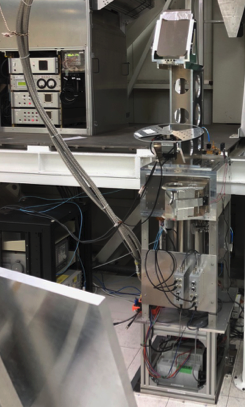
The 2mm B4R installed in the instruments room of the LMT.
The B4R is the receiver system which consists of 2 mm receiver and a dedicated digital spectrometer composed of four XFFTS boards. The 2mm receiver is a single-beam two-polarization receiver which is based on ALMA band-4 “2SB” (two-polarization sideband-separating) mixer (Asayama et al. 2014, PASJ, 66, 57). It was re-designed for the LMT and for the use of two stage Sumitomo GM 4K cryocooler. The optics of the B4R is designed to fully use the 50 m diameter of the LMT with an edge level of – 12 dB. The specifications of the B4R are summarized in Table 1 together with the specification of the XFFTS spectrometer. The four spectral windows (spws) are placed to the lower sideband (LSB) and the upper sideband (USB) for both polarizations (see Fig. 1). The B4R was installed and commissioned in 2018, and demonstration science observations were performed in Autumn 2019. During the commissioning and science observations, it was confirmed that the B4R on the LMT meets the basic ALMA specifications, and the beam size was measured to be about 10 arcsec in FWHM and the aperture efficiency was 46±6 % at 147 GHz. The typical system noise temperature, Tsys, was 100 K during the observations. Both position switching mode (PS; e.g., for high-z CO line detections and spectral scan observations) and On-the-Fly mapping (OTF; for wide area spectral line mapping covering, e.g., 10 arcmin x 10 arcmin.) are available using the B4R.
The 1st IF is 4 to 8 GHz, and the 1st LO composed of a synthesizer and multiplier chain. The first IF is down-converted using the 2nd LO (or 2nd IF reference) signal from other synthesizers to the final IF signal DC-2.5 GHz. The four sets of the IF signals are fed to the spectrometer via bandpass filters. The observing frequencies at the USB (fUSB) and the LSB (fLSB) are calculated as follows:
where fLO is the 1st LO frequency, fIFref is the 2nd IF frequency (8.1 GHz for the default frequency setting), and fUSB, XFFTS or fLSB, XFFTS are the XFFTS frequencies.
For example, if we select fLO = 140 GHz, the observing frequencies are fUSB = 145.6-148.1 GHz and fLSB = 131.9-134.4 GHz. Note that both band edges at the final IF at the spectrometer (i.e. 0.0 – 2.5 GHz), 0.0 – 0.1 MHz and 2.4 – 2.5 GHz are contaminated by out-band spectral signals due to aliasing of AD converter in the XFFTS board and the 2nd down conversion, respectively.
Sensitivity and integration time calculators for the 2mm B4R system are available in LMT-Hedwig, the LMT’s proposal submission system.